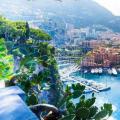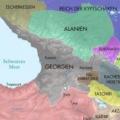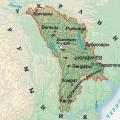Kachanka estate. Palace and park complex Tarnovskiy Estate, Kachanovka Village What can you see in “Kachanovka”
Story

Unknown artist. Portrait of Pyotr Rumyantsev-Zadunaisky.
The Kachanovsky ensemble is one of the most striking examples of estate architecture. This landmark of Ukraine is located in the southeast of the Chernihiv region in the Ichnyansky district, on the banks of the Smosh River. The estate was founded by the Russian commander, Count Rumyantsev-Zadunaisky (1725-1796), as one of the residences of the president of the Little Russian Collegium and the governor-general of Little Russia (then the name of Ukraine in the empire).
In 1824, Grigory Stepanovich Tarnovsky became the owner of the estate. The Kachanovka estate belonged to the Tarnovsky family until 1897. The threat of ruin and the desire to improve their financial situation forced the Tarnovskys to sell the estate to Pavel Kharitonenko, a millionaire sugar manufacturer. The estate was in good hands, it was carefully completed, electricity and telephone were supplied here. The additions from Kharitonenko’s time did not distort the classic character of the palace house, which remains to this day.
In 1914-1918 the estate was the property of Kharitonenko’s eldest daughter, Elena, and her husband, Mikhail Olive. Among the guests of the Olive family were artists Dobuzhinsky and Petrov-Vodkin.
In 1918, the estate was taken away and nationalized. From 1925 to 1933, a children's colony was located here. During the war there was a hospital, then a tuberculosis sanatorium. The estate and park became a state historical and cultural reserve on November 24, 1981.
Manor in the 19th century
Kachanovka played an important role in the work of many artists of those times. During 1836-1838. The artist, student of the Academy of Arts Vasily Sternberg, spent his summer vacations in the estate. In the summer, composer Mikhail Glinka was actively working on the opera “Ruslan and Lyudmila” in Kachanovka. Here he wrote songs and romances in honor of G. Tarnovsky Hymn to the master. After his departure, the cult of the composer was forever established in the estate.
The park has a small regular part near the manor's palace and a large landscape part. Park bridges, the Hills of Love and Fidelity, and “Romantic ruins” on the shore of the Great Reservoir, which are a characteristic feature of landscape gardening art of the late 18th and early 19th centuries, and traces of the sentimentalism style, have been preserved here. Laughter, jokes, and noisy amusements of the Baroque and, partially, Rococo eras were banished from the landscape parks of that time. But long horseback rides, pavilions and small architecture structures that referred to literary, historical or memorable events were welcomed. In Kachanovka Park, such a place was the Glinka Pavilion, where the composer allegedly worked.
Glinka Pavilion
Built in brick in the 1830s in the Romantic style, plastered. Octagonal in plan, the cellars are topped with a figured, almost baroque dome with a figured spire. The windows and doorway are lancet-shaped, with medallions and a profiled cornice above them. The walls are completely whitewashed with whitewash without highlighting the architectural details. The total height of the pavilion (with basement) is 16 meters.
After the forced sale of the estate in 1897 to Pavel Kharitonenko, part of the manor house was rebuilt and supplemented with a small water tower. It was probably at the same time that the floors in the Glinka Pavilion were laid with metal tiles. During World War II, the pavilion was badly damaged and was restored in 1947. The dome is painted green.
Church of St. George
The manor church is dedicated to St. George. Built in 1817-1828. in the style of late classicism. Cross-shaped in plan with an elongated western part. The western portal is accented by a four-column portico. The side porticos of the church and the 2 upper tiers of the bell tower were lost, which noticeably distorted its architectural appearance. In the western part of the church there is a choir, where a spiral staircase in the thickness of the wall leads. The rust on the facades is densely whitewashed without highlighting the architectural details. The church needs restoration and restoration of its original appearance.
Collection
V.V. Tarnovsky became interested in collecting during his student years. The basis for the unique collection was Cossack relics. Among the rarities of the collection were the saber of B. Khmelnytsky, personal belongings of I. Mazepa, S. Paliya, P. Polubotok, K. Rozumovsky, Cossack sabers, kleinods, hetman station wagons, portraits of many figures from the times of the Cossack movement. It was a real museum of Ukrainian studies. The Kachanovsky collection was estimated by contemporaries at several hundred thousand karbovanets in silver. In fact, it was and remains, even in divided form, priceless. Interest in the collection brought Ilya Repin to Kachanovka to continue the film Cossacks write a letter to the Turkish Sultan. Throughout almost the entire summer 1880 the artist inspiredly sketched Cossack relics, painted portraits of the owners of the estate, landscapes of Kachanovka (estate) on Wikimedia Commons
Kachanovka is a palace and park ensemble located near the village of the same name, Ichnyansky district, Chernihiv region of Ukraine. It began to take shape in the 1770s, and received its greatest development in the middle and second half of the 19th century.
In 1981, on the basis of the ensemble, the Kachanovka historical and cultural reserve was created, which in 2001 was awarded national status. It is the only one among the estates of eastern Ukraine that has been preserved as a complex.
In 1771, on behalf of Empress Catherine II, the farms of Parafievka and Kachanovka were purchased by the treasury and in December of the same year they were presented to the Russian commander Count Pyotr Alexandrovich Rumyantsev-Zadunaisky, who decided to create in his new estate one of the residences of the President of the Little Russian Collegium and the Governor-General of Little Russia .
By his order, according to the design of the Moscow architect Karl Blank, the Little Russian architect Maxim Moscepanov erected a large palace in the pseudo-Gothic style. And soon, a park was laid out around the palace by M. Moscepanov, and in March 1777, Pyotr Rumyantsev personally gave orders for its construction: “I would like, without wasting time in the Kachanovsky farm, the prospect that you started from grove to grove, were extended on the right all the way to the birch grove, and from the left all the way to the road that the gardener directed to the peninsula... March 21, 1777.”
At the same time, several service premises and outbuildings were built in the estate next to the palace, and several decorative buildings were erected in the park, of which only the grotto under the “Glinka’s gazebo” on the hill above the pond and the architectural composition “Romantic Ruins” have survived to this day.
After Pyotr Rumyantsev in 1796, the estate in Kachanovka was inherited by his son Sergei Petrovich Rumyantsev, who on May 19, 1808 sold it and all the property granted to his father in the Chernigov province to Grigory Yakovlevich Pocheka and his wife Praskovya Andreevna. During their ownership of Kachanovka, the estate was significantly rebuilt - on the site of the demolished Rumyantsev palace, a one-story building in the style of Russian classicism was built, and the park was redesigned. Praskovya Andreevna, who after the death of her husband in 1816 became the sole owner of the estate, began construction of the St. George Church, completed in 1828, after her death.
After the death of Praskovya Andreevna in 1824, the estate, according to their joint will with her husband, due to their childlessness, passed to her son from her first marriage, chamber cadet Grigory Stepanovich Tarnovsky).
Grigory Tarnovsky began construction of a large palace in the classicist style. During his time, the second floor was completed, with a low drum on which a dome was located, which gave the building a more centric character, and the facades were decorated. The layout of the park has also changed.
At the estate, Tarnovsky collected a large library and a collection of paintings, among which were works by the most famous Russian and European masters, started a home orchestra, having bought a famous serf violinist from his neighbor Grigory Galagan, and at the same time a Stradivarius violin.
Considering himself a patron of the arts, Grigory Tarnovsky turned Kachanovka into a center of local cultural life. Many famous writers, poets, composers, and artists visited Kachanovka. In 1835-36, Nikolai Gogol visited the Tarnovskys for the first time. In 1838, Mikhail Glinka lived in Kachanovka all summer.
On the estate, the famous composer loved to work in the Rumyantsev grotto under the gazebo on the hill next to the pond. Since then it has received the name “Glinka’s gazebo”. Here he continued to work on the opera “Ruslan and Lyudmila”, in particular, “The Ballad of Finn” and “Chernomor’s March” were written, which were first performed by Tarnovsky’s musicians in the main dining room under the direction of Glinka himself. In addition, the composer conducted a choir several times in St. George’s Church, in which baritone Semyon Gulak-Artemovsky, who came with the composer, sang. After visiting Kachanovka, Glinka, using the words of N. Markevich, wrote a pathetic cantata “Hymn to the Master,” dedicated to Grigory Tarnovsky.
Under Vasily Tarnovsky Jr., Kachanovka again became one of the centers of cultural life, which was visited by famous artists, writers and scientists of the time. Interest in his collection brought Ilya Repin to Kachanovka, who was working at that time on the painting “ Cossacks write a letter to the Turkish Sultan" The artist spent almost the entire summer of 1880, together with his student Valentin Serov, at the estate. He captured the owner of the estate in the image of a gloomy Cossack in “Cossacks,” the painting “ Zaporozhye Colonel» (« Hetman") and the figure " Cossack", and his wife Sofya Vasilievna in the film " At the piano».
Patronage ruined the Tarnovskys at the end of the 19th century, and the palace in Kachanovka was put up for auction. The estate was bought by the sugar king of the Russian Empire, Pavel Kharitonenko, paying 1 million gold rubles.
The sugar factory modernized the facade, built water supply and sewerage, installed electricity and telephone, and subsequently gave Kachanovka as a wedding gift to his daughter Elena and her husband, Prince Mikhail Urusov.
When the newlyweds walked down the aisle, Kharitonenko ordered the main park alley to be covered with sugar, which was supposed to symbolize a sweet life for the newlyweds.


The estate was founded by the Russian commander, Count Rumyantsev-Zadunaisky in the 1770s, as one of the residences of the Governor-General of Little Russia.
The estate experienced its second construction period in 1808-1824 under the new owner - Ukrainian landowner Grigory Pochek (1765-1816). The territory of the estate is expanding, the palace is being rebuilt in the style of Russian classicism, new buildings for various purposes are being erected, and a landscape park is being laid out.
In 1824, after the Tarnovsky landowners and philanthropists took possession of Kachanovka, the most interesting period in the history of the estate began. Lasting for more than 70 years, it brought fame to this magical corner of the Little Russian region as a unique cultural and artistic cell that attracted the best representatives of the creative intelligentsia. This was facilitated by the architectural and artistic environment, the friendly hospitality of the owners and the uniqueness of Ukrainian nature, personified in a huge manor park with an area of over 600 hectares.
In the Kachanovsky album for guests, N. Gogol, P. Kulish, N. Kostomarov, M. Vrubel, D. Yavornitsky, M. Markevich and many other famous artists, scientists, public and cultural figures left autographs. In total, the album contains more than 600 autographs.
In the summer of 1838, Mikhail Glinka worked fruitfully on the opera “Ruslan and Lyudmila” in Kachanovka. Here he wrote songs, romances, and a cantata in honor of G. Tarnovsky “Hymn to the Master.” Some works were performed for the first time accompanied by a local serf orchestra, conducted by the maestro himself. After Glinka’s departure, the cult of the composer was forever established in the estate. And now on the hill, near the Major Pond, there is a slender, white-stone gazebo named after him.
It is significant that Taras Shevchenko in May 1843, during his first trip to Ukraine, traveled from St. Petersburg with a direct destination to Kachanovka, where he had previously sent his best painting “Catherine”. The last visit of the Great Kobzar to the Tarnovsky estate is dated August 21, 1859, when he left a note in the autograph album: “And the path where you walked was overgrown with thorny thorns...”. In the estate park there is a clearing where, under a century-old oak tree, the poet communicated with local peasants and serf musicians.
The Kachanovsky ensemble is one of the largest, and perhaps the most striking example of estate architecture on the territory of Left Bank Ukraine, created in the best traditions of world palace and park art.
 Did you know that...? Little-known facts about Monaco. Interesting facts about Monaco (13 photos) Unusual and interesting
Did you know that...? Little-known facts about Monaco. Interesting facts about Monaco (13 photos) Unusual and interesting Round table: "for" and "against" the referendum on renaming the republic Renaming South Ossetia into the state of Alania
Round table: "for" and "against" the referendum on renaming the republic Renaming South Ossetia into the state of Alania Map of moldova with cities
Map of moldova with cities